Menu
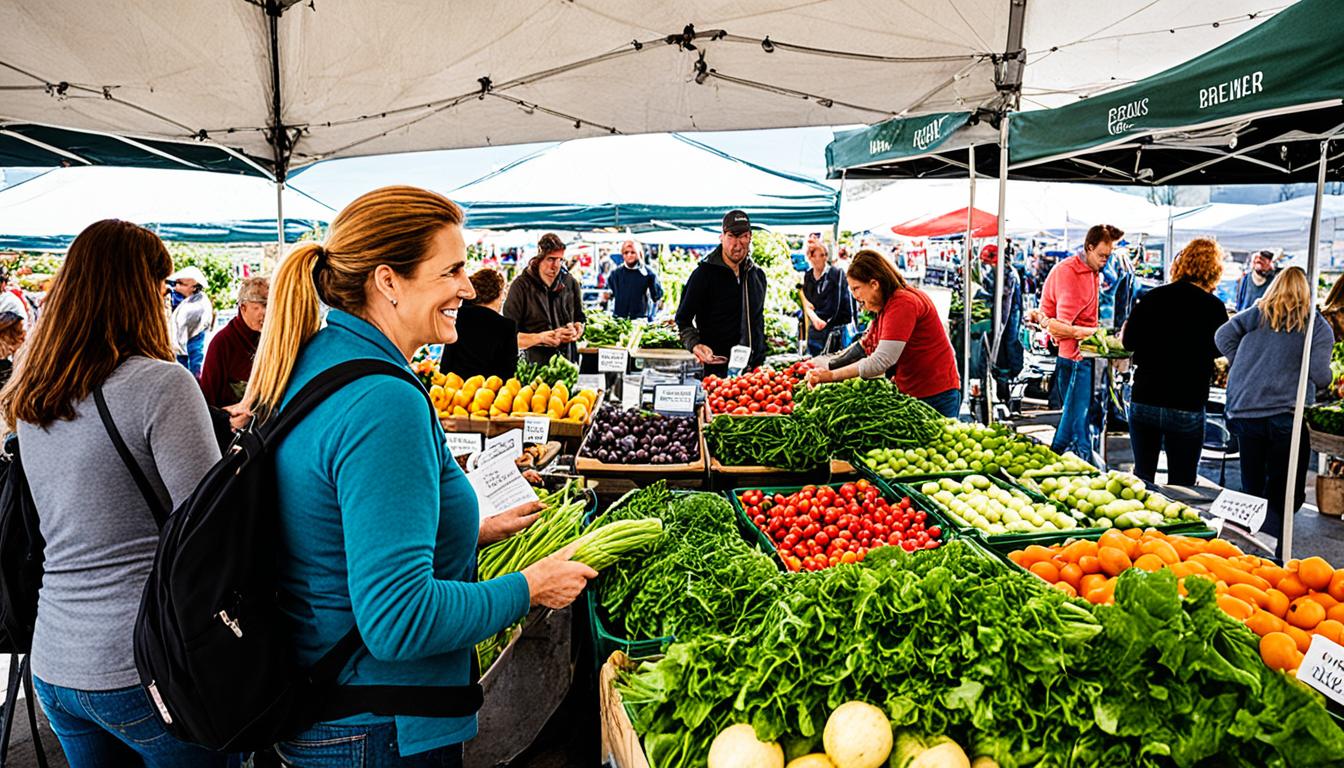
Did you know the United States saw a big jump in farmers’ markets? From 1,755 in 1994 to 8,669 in 2016, people clearly want local food. This surge supports the local food movement and has a big effect on direct sales.
The Moab Grown project shows how linking local farmers with chefs and shops helps everyone. It boosts the local economy and supports eco-friendly farming practices through initiatives like composting. Such efforts not only help the economy but also move towards a more sustainable future by reducing pollution.
Furthermore, laws like the Food Safety Modernisation Act (FSMA) have stepped up to support small farmers. They are exempt from some overbearing rules. This creates a safer way to produce food without hurting small farms. It’s a win for safety and the environment.
The local food movement brings food producers and consumers close together. It aims to make sure food travels a short distance before reaching you. Its goal is not only to be eco-friendly but also to support local farmers and communities.
Local food means your food is grown, processed, and sold nearby. This idea encourages buying from farmers directly or through markets. Farmers’ Markets, farm-to-school programs, and CSA schemes help grow local food networks. CSA programs also make it possible to use SNAP benefits, making local food more accessible.
The idea of eating locally has deep roots. Communities often depended on food grown close by. More recently, the concept of being a ‘locavore’ got popular. It means choosing food grown within 100 miles. This comes from the Slow Food movement, started in 1986, which promotes sustainable and ethical farming.
Farmers’ Markets have grown a lot. In the U.S., there were 1,755 in 1994, but by 2016, this number had jumped to 8,669. This shows more people are interested in buying local produce. It not only supports local farmers but is also better for the environment. Eating locally produced food helps lower the carbon footprint.
| Key Trends | Data Insights |
|---|---|
| Expansion of Farmers’ Markets | Growth from 1,755 in 1994 to 8,669 in 2016 |
| Consumer Willingness to Pay Premiums | Acceptance of premiums for organically grown, locally sourced produce |
| Environmental Focus | Exploration of environmental-friendly beef production methods |
| Sustainable Practices | Backyard beekeeping, rainwater harvesting, composting |
The benefits of direct sales are huge. In 2007, these sales reached $1.2 billion. This was 0.4% of all agricultural sales. Their growth is impressive, rocketing by 105% from 1997 to 2007. This beats the 48% rise of all agricultural sales.

Direct sales boost money for small farms. In 2007, 136,800 farms sold directly to consumers. This lets small farms get more of the food dollar. They skip the middlemen, keeping more money to put back into their work. This helps them grow and become more financially secure.
Direct sales also cut down supply chain costs. Direct models have shorter chains. This means less money is spent on handling and storing food. Using resources more efficiently, like recycling greywater, also saves money. These savings help local food be less expensive to produce.
Direct sales create jobs in the local food industry. The number of farmers’ markets grew a lot, from 1,755 in 1994 to 6,132 in 2010. This boom in local food has helped create even more work. Local food efforts also help the environment and get people more involved. By supporting green and sustainable farming, local areas get stronger economically and their communities more united.
We must grasp the impact of direct sales on small farms and communities. Local food systems support strong economies and earth-friendly food ways. They show how we can make good food choices while caring for our planet and each other.
Farmers’ markets offer many benefits beyond just making shoppers happy. They help people get fresh produce easily, support local farmers, and boost the local economy. As someone who supports local food, I see how important farmers’ markets are.
Farmers’ markets are great for getting fresh, organic produce. In Utah, people love this kind of food. These markets sell fruits and veggies that are in season. Buyers can get the best food straight from the farm. This is good for their health and it shows them the wide variety of local farming.
These markets are a big help to the local economy. They let local farmers keep more money from what they sell. National research shows farms keep nearly all of what they earn at these markets. This is much better than with regular stores.
They also create jobs and boost spending locally, which helps the whole community. This makes a big difference in towns and cities.
At markets, people get to know the farmers. This builds a strong sense of community. It’s good for the farmers and keeps money in the local area. So, everyone benefits.
Community-supported agriculture (CSA) changes how we get food. It lets people buy food straight from a local farm. They become a “member” by getting a share. This way, farms and people work together. It keeps local farms strong and creates a fair local food network.
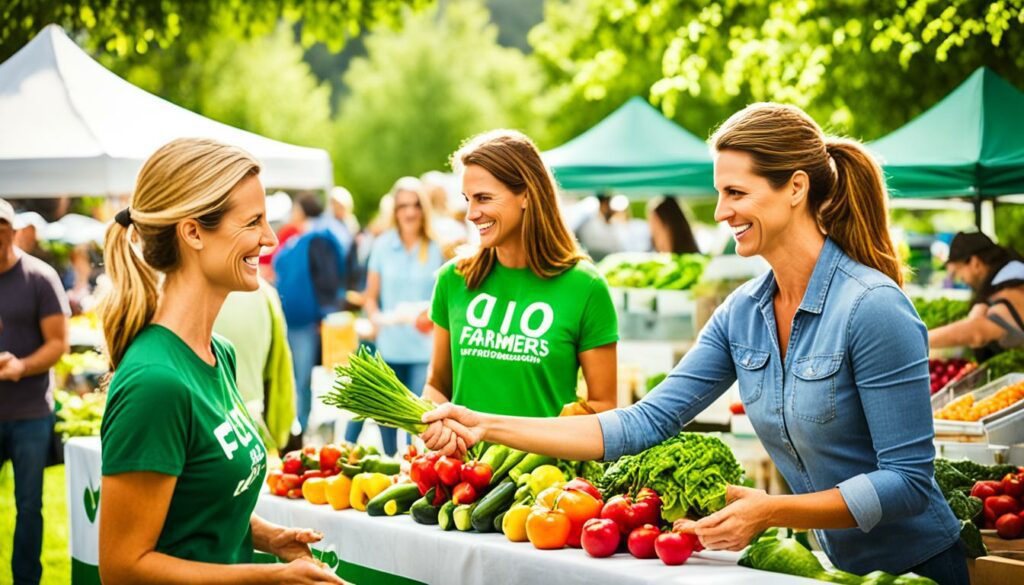
CSA models help farms stay financially stable. People pay at the start of a season to get a range of fresh produce. This helps farmers with the costs of planting and growing. It also means they can plan their budgets and prices well. In California, CSA farms get extra support to make their businesses a success.
CSAs are all about being good to the environment. They use methods that are kind to the earth. This improves the soil, lowers carbon footprints, and helps plants and animals thrive. Even the USDA says CSAs are key to a greener, fairer food future. These farms can take SNAP payments, thanks to their important efforts.
Groups like Urgenci bring CSAs from around the world together. They help spread the idea of food sovereignty. With so many resources and support, CSAs are leaders in keeping farming sustainable and incomes steady.
| CSA Resources | Support Types |
|---|---|
| Local Harvest Directory | Provides information on CSA farms in California and across the U.S. |
| National CSA Community of Practice | Strengthens resources, programs, and training opportunities |
| Urgenci Network | Promotes solidarity and food sovereignty globally |
| CSA Innovation Network | Offers marketing resources and member tips |
The farm-to-table movement has changed how food gets to us, making it easier for farmers and consumers to connect. In 2012, local and regional food sales reached about $6.1 billion. This shows a big want for meals made with local ingredients. It also highlights the good sides of selling directly to stores.
Local sourcing in restaurants is key for the farm-to-table way. Many places now team up with nearby farms, bringing fresh food straight to the table. A great example is Chez Panisse in California. Since 1971, they’ve been leading the way in using local produce. These links make sure diners get top-notch food, help the local area, and care for the environment.
There are several ways farmers and customers connect more directly. Things like cooperatives, CSA schemes, and food hubs help. They let farmers sell their goods right to the store, so food stays fresher. This also means more money goes back to the farmers. In 2007, the National Farm to School Network started. It helps schools buy fresh and healthy food straight from local farms.
People are really into food that’s from close by, from the oldest generations to the youngest. The farm-to-table idea is all about clear information, freshness, and being kind to our planet. It’s made everyone more interested in organic and easily traceable food. So, when we shop and eat, we now think more about our health and the world around us.
| Year | Event |
|---|---|
| 1915 | USPS initiated food shipments from farm to city. |
| 1971 | Chez Panisse restaurant opened, featuring farm-to-table fare. |
| 2007 | National Farm to School Network established. |
The local food movement has made sustainable agriculture important worldwide. The word “locavore” was picked by The New Oxford American Dictionary in 2007. This shows people like to eat food from nearby and support farming that protects the planet.
Farmers markets have grown fast thanks to this movement. In the U.S., the number of markets went up from 1,755 in 1994 to 8,669 in 2016. It shows more people want fresh, locally grown food. And 85% of what’s sold at these markets is grown less than 50 miles away. This means less pollution from food transportation and more chances for eco-friendly farming.

The push for agriculture best practices is clear. About half of USDA-certified organic farms sell their food locally. Even though only a small percentage of local food is certified organic, the movement helps them survive. It encourages methods like permaculture, which is great for the soil and the environment long term.
The local food movement has also helped small and medium farms do better. These farms were struggling a while back. Now, with more local markets, they have new ways to sell their produce. The movement also pushes these farms to use good farming methods. This way, they make money in a way that’s good for the earth. Plus, it reduces the need to import food, which is good for a country’s food safety.
This movement pushes for farming that’s good for the planet. It supports things like composting and permaculture. This helps create farms that can deal with the changes in climate. So, the local food movement is making a real difference by leading to better farming practices.
The demand for organic food is growing. People are willing to pay more for these products. This is because they care more about their health and are aware of how their choices affect the planet. Many farmers are changing to organic methods to meet this demand.
Organic farming means not using synthetic pesticides and fertilizers. It’s better for the health of farm workers. Plus, it fits with the growing desire for local foods. This is good news for everyone who loves organic products.
More and more people are choosing organic. In Utah, studies have shown that people prefer organic foods and are willing to pay extra for them. This shift shows a move towards choices that are healthy and planet-friendly.
Farmers are moving to organic farming to keep up with the demand. The number of organic products at farmers markets has gone up a lot. This is good for both the farmers and the people who love organic food.
Special programs like Double Up Food Bucks help make organic food more accessible. They support the use of SNAP benefits at farmers markets. This not only helps people eat better but also encourages the growth of organic farming.
Local food producers face unique challenges in the U.S. They must follow complex rules to reduce pollution. This includes guidelines from the EPA and Best Management Practices. Despite this, they benefit from USDA programmes. For example, they can take SNAP benefits at farmers markets. This helps more people buy fresh, local food.
Local producers face issues like reaching markets and changing demand. However, they have great chances in the local food market. Many consumers prefer high-quality, local items. In places like Utah, people pay more for organic, locally grown food. This creates a big chance for small food businesses to do well.
Local farming has benefits beyond money. For instance, beekeeping helps the environment and your health. In Utah, composting improves soil and helps farming to be sustainable. The idea of permaculture shows how local farmers can work in a way that is good for the earth.
Small food businesses offer new ideas and help their communities. Projects like CSA bring in steady money and support good farming. They also help with social and environmental issues. This shows how important local food producers are in their communities.
But, there are still challenges. Very few local food sellers are organic, because getting certified is hard. Also, there are fewer medium farms today. This might not be good for the future of local food production. Producers need new ideas and strong local support to keep going.
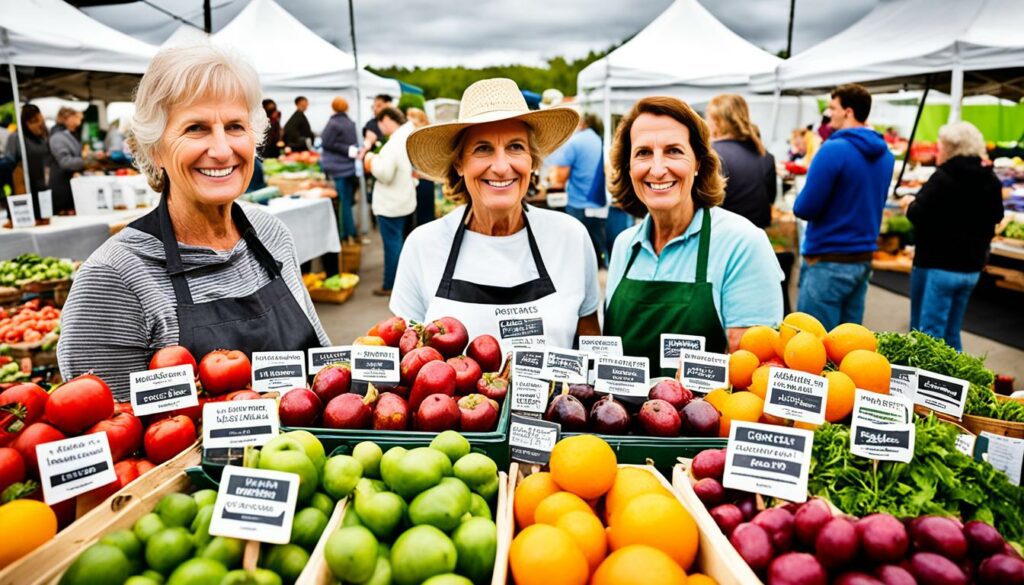
Urban farming is a hopeful response to food deserts. These projects turn empty spaces into places that grow food. Studies, like the one from John Hopkins University, show that poor city areas often lack big shops. Urban farming can help make good food more available in these places.
| Opportunities | Challenges |
|---|---|
| High consumer demand for local, organic produce | Complex regulatory environment |
| Revenue stability with CSA programs | Stringent organic certification processes |
| Environmental benefits of sustainable practices | Market access and consumer demand fluctuation |
In conclusion, small-scale food production has many chances and hurdles. With new ideas and help from their communities, producers can overcome difficulties. They play a key role in the food system’s health. Their determination and ability to adapt support a vibrant local food scene. This is crucial for a sustainable future.
The local food movement faces many food industry regulations. Understanding and working with these rules can strengthen local food systems.
Federal food policies are key in shaping the local food market. As of 2015, only a few big companies dominated beef, pork, and chicken. State agriculture support helps smaller farms. Now, every state has branding programs to highlight local products. This effort, alongside the Food Safety Modernisation Act, supports small farms.
Local food systems thrive because of community support. Projects like farmers’ markets grew from 1,755 to 8,268 locations, making $1 billion yearly. Non-profits are also crucial. They help with education and resources for small farms. By 2012, over 40% of school districts took part in farm-to-school programs. This shows strong community support. Non-profits also provide training that fits with state policies and promotes sustainable farming.
In recent years, technology has changed the way we see local food, especially in direct sales. Now, farmers and small producers can use the internet and e-commerce to sell to more people. This means they can reach a bigger market and have more chances for direct sales.
More people are buying local food online, thanks to digital sales platforms. These websites and apps connect farmers with buyers, making it easier to get local food. A great example is CSA programmes, which let people subscribe to get fresh produce straight from local farms.
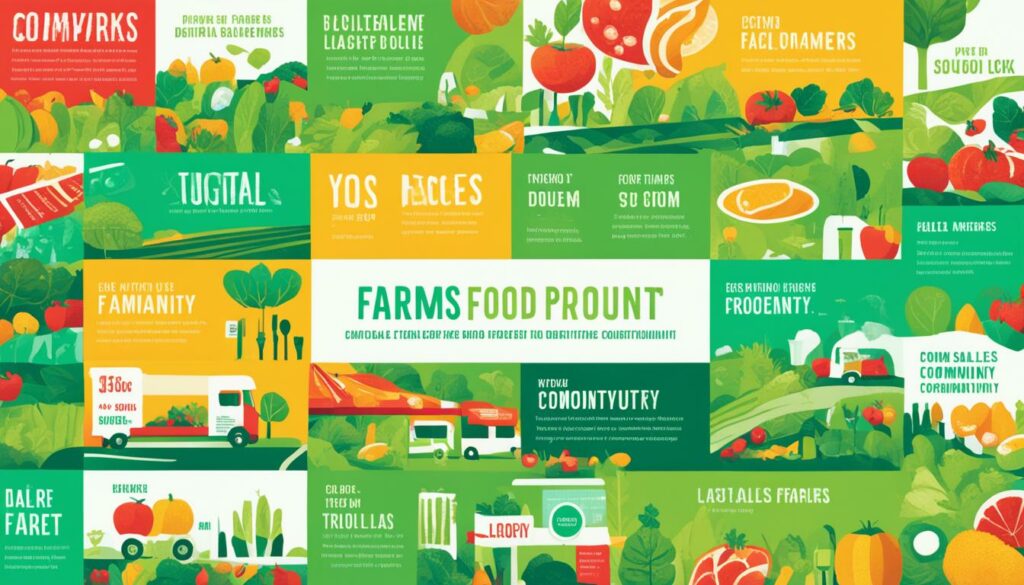
Mobile payments are also changing direct sales. They let farmers take payments anywhere, fast and with no hassle. This technology makes selling at markets and straight to customers better. It builds trust and a community feeling. These payments are also important for e-commerce and farming, offering safe and easy ways to pay.
In short, new tech like online selling, e-commerce, and mobile payments is making a big difference in direct sales. It’s good for both sellers and buyers. This new way of selling local food helps communities come together and makes getting good food easier and more sustainable.
The local food movement is key in fighting climate change. It promotes ways to farm sustainably, which cuts down on harmful emissions. These efforts benefit the planet and our food supplies. Small farmers and cottage food makers, not under heavy rules, are vital. They get help from places like universities for important farming knowledge.
Locally grown food is very safe, showing from stories and surveys. The low chances of sickness from this food build trust. Local farms use short supply chains, meaning less pollution is made. This helps a lot in the fight against climate change.
Support for the local food scene comes from individual money, loans, and grants. This help is key for farmers to go green in their methods. Programs like Community Supported Agriculture do more than help money-wise. They also benefit the community and nature, showing farming’s bigger picture.
People like the idea of local and organic food more and more. This is seen in Utah’s farmers’ markets. Programs that help pay for food, like Double Up Food Bucks, make it easier to eat local. They also aid in keeping our food ways sustainable.
Choosing farming that’s ready for the climate does a lot of good. It not only helps food grow better but also keeps the land healthy. Reusing waste and keeping bees at home also help the farming world be more self-sufficient.
Using the Best Management Practices and regrowing aspen trees in Utah shows a commitment to our planet. These efforts are a big part of keeping our food sources and climate stable. They show real change can start in local communities.
Looking into local food systems shows us a lot about selling directly. These stories talk about small farmers and their customers working closely. They stress how important it is to keep things short and simple, buying face to face. It shows how local farmers are quick to adjust and stand strong in tough markets.
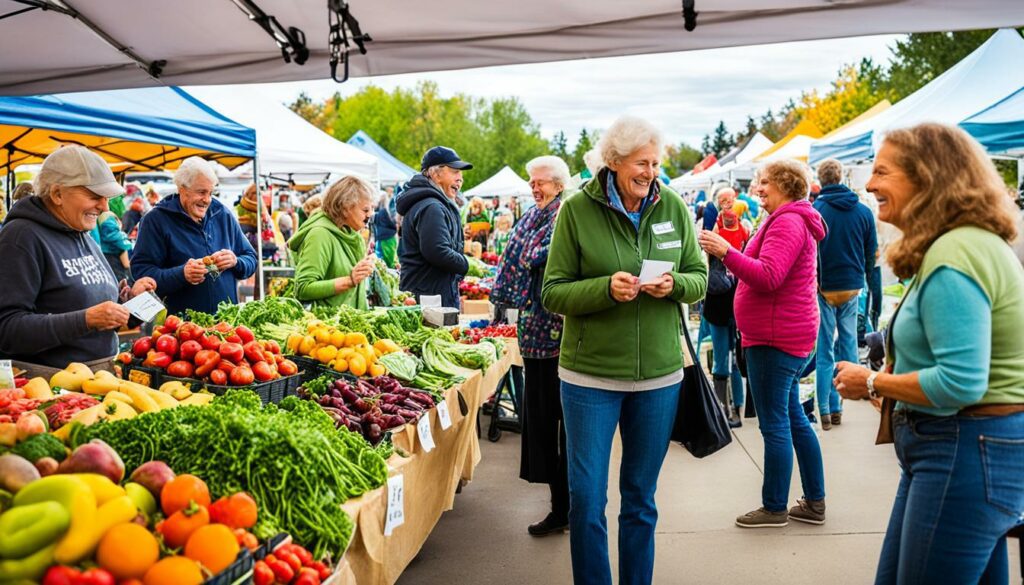
Local food businesses are often small, which means they focus a lot on their communities. This is true according to research from universities and non-profits. They say these businesses always keep learning. Also, they usually get money from the local community or the government, not big companies.
Research findings on direct sales are quite eye-opening. For example, smaller food producers can take advantage of special rules in the Food Safety Act. This makes starting out easier. But, these businesses must keep the trust of their customers. People are happy to pay more for food they think is safe.
Farmers markets have been on the rise from 1994 to 2016, showing strong growth. Despite doing well, meeting all the rules can be tough for these farmers. This is a big challenge for them.
| Aspect | Data |
|---|---|
| Acceptance of Food Safety Culture | Widely accepted, but many companies need improvement |
| Employees in Local Food Businesses | Typically small number |
| Investment Sources | Personal funds, small business loans, grants |
| Farmers Markets Growth | From 1,755 in 1994 to 8,669 in 2016 |
| Consumer Trust and Willingness to Pay | High, consumers pay a premium for perceived safety |
The success of direct sales shows how much local producers and their communities need each other. It proves the potential for a stronger and lasting local food network.
Today, it’s very important to support local agriculture. The U.S. has seen a big increase in the number of farmers markets. From 1994 to 2017, they jumped from 1,755 to over 8,000. This growth shows more people are getting involved in local food systems. By buying at these markets, we support local growers and get to know the people who grow our food.
Learning about local food is key to getting people to buy from nearby farmers. The term ‘locavore’ won the Word of the Year award in 2007. It shows a big interest in eating food from nearby. Teaching people about the good things of local food not only sells more but also helps spread the word about being kind to the planet.
Community events and food fests are great for helping local growers and producers. They let our neighbours talk to us about how they grow food and show us the great things they make. In Utah, they’ve got 45 farmers markets. This shows the state really wants to push local agriculture.
There’s also the Terra Madre network, which is part of the global Slow Food movement. This group is in 150 places around the world. They help small food makers come together. They don’t just show us what our area makes. They also teach us about different cultures and make our towns better places to be. By going to these events, we show local farmers we care about them.
Here’s how quickly farmers markets have grown in America:
| Year | Number of Farmers Markets |
|---|---|
| 1994 | 1,755 |
| 2016 | 8,669 |
These numbers show us that farmers markets are getting bigger. It proves there is a push to back local agriculture and help us all enjoy fresh, local food more.
The local food movement has greatly changed how food is sold, bringing big benefits for the economy, environment, and society. In the US, sales of local foods jumped from $5 billion in 2008 to $11.8 billion in 2017. They slid a bit to $9 billion in 2020 after that. This boost not only helps local farmers but also boosts local spending.
Local businesses tend to buy their supplies close by. This action means more jobs and stronger ties within communities. They also cut down on food waste. Local farms can waste up to 42% of their food. Less food shipping would help lower harm done to the planet.
People love the idea of getting fresh, healthy, and top-quality food from local sources. And as locals buy from locals, they make their areas stronger economically. From 1997 to 2007, direct sales to consumers more than doubled, showing increased demand. The rise of farmers’ markets and groups supporting local farms also points to how the movement is growing. Looking ahead, keeping focus on being sustainable and local in how we eat will bring long-lasting good effects. This way, we build a food system that’s both strong and good for the planet for generations to enjoy.
The local food movement promotes short supply chains. It focuses on direct sales to consumers. This approach helps small food producers, lowers costs, and encourages sustainable farming.
The movement’s size and goals vary. It’s mainly about direct sales and community involvement. Farmers’ Markets and CSAs are key. They help local economies and support eco-friendly farming.
The movement began with age-old farming and evolved. Now it aims for benefits like local growth, cleaner air, and healthier communities.
Trends show more people are using Farmers’ Markets and CSAs. The demand for organic food is up. Farm-to-table is also growing. Technology, awareness, and policy support are boosting these trends.
Direct sales cut out middlemen, boosting profits. They also mean more community support. This helps local economies grow.
Farmers’ Markets offer fresh produce. They boost the local economy through local spending. They also create jobs, support farmers, and encourage healthier eating.
CSA programmes help farmers financially and promote sustainable farming. They create strong bonds between farmers and consumers. Members get fresh, seasonal produce.
Farm-to-table links farms directly to places that serve food. It ensures fresh, local meals. This model highlights the value of good, sustainable food.
It supports practices like permaculture, organic farming, and recycling. These methods improve soil, cut down on harm to the planet, and adapt to climate change.
The demand comes from more people wanting health and eco-friendly foods. Farmers are responding, selling directly and using organic methods more.
They have benefits like strong consumer ties and artisanal interest, but face hurdles. These include rules, getting into markets, and needing more resources. They must innovate and plan carefully.
Regulations and help from various groups are important for producers. They offer knowledge and support for food safety and running a business well.
Technology is pushing local food sales forward. Things like online platforms and mobile payments make buying local food easier. They help grow and connect communities.
By travelling fewer miles, the local food scene cuts down on pollution. It also supports farming that can weather climate change. These steps align with global efforts to protect the Earth.
Case studies show the ups and downs of local food projects. They reveal benefits for economy, society, and the planet. They’re a guide for making direct sales and local food work well.
By learning, joining events, and buying local, consumers can make a big difference. This supports a healthy, local food supply and the economy.